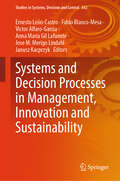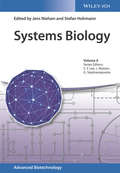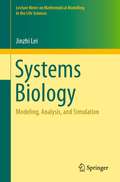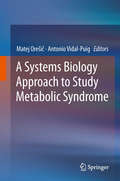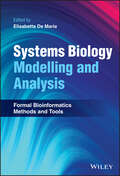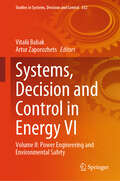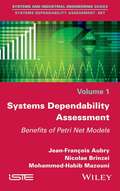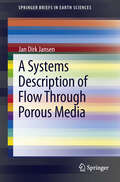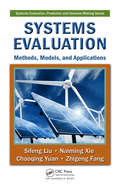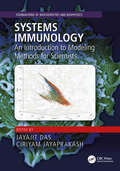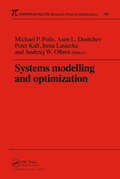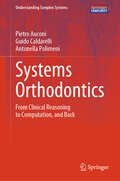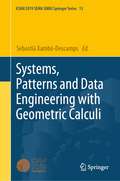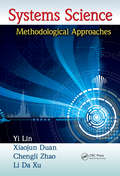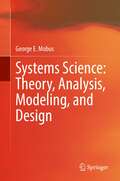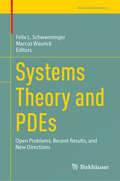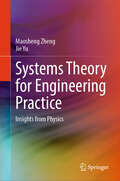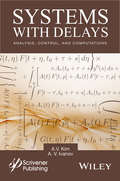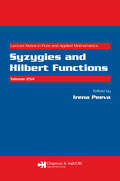- Table View
- List View
Systems and Decision Processes in Management, Innovation and Sustainability (Studies in Systems, Decision and Control #562)
by Ernesto León-Castro Fabio Blanco-Mesa Victor Alfaro-Garcia Anna Maria Gil Lafuente Jose M. Merigo Lindahl Janusz KacprzykThe book presents a series of papers with different methodologies that allow us to visualize how the systems support decision-making in areas such as the tourism sector, entrepreneurship, quality of work life, gender, motivation, circular economy, innovation, law, finance, and bibliometrics. The book also finds a series of cases applied in different countries, where through the information collected and the data analyzed, new improvement processes can be generated at the business level and the local, regional, and national levels within Ibero-America. The book presents new methods and systems to create better decision-making processes in the changing and uncertain environments in which people, companies, and governments interact.
Systems Biology
by Stefan Hohmann Sang Yup Lee Jens Nielsen J. Nielsen Gregory StephanopoulosComprehensive coverage of the many different aspects of systems biology, resulting in an excellent overview of the experimental and computational approaches currently in use to study biological systems. Each chapter represents a valuable introduction to one specific branch of systems biology, while also including the current state of the art and pointers to future directions. Following different methods for the integrative analysis of omics data, the book goes on to describe techniques that allow for the direct quantification of carbon fluxes in large metabolic networks, including the use of 13C labelled substrates and genome-scale metabolic models. The latter is explained on the basis of the model organism Escherichia coli as well as the human metabolism. Subsequently, the authors deal with the application of such techniques to human health and cell factory engineering, with a focus on recent progress in building genome-scale models and regulatory networks. They highlight the importance of such information for specific biological processes, including the ageing of cells, the immune system and organogenesis. The book concludes with a summary of recent advances in genome editing, which have allowed for precise genetic modifications, even with the dynamic control of gene expression. This is part of the Advances Biotechnology series, covering all pertinent aspects of the field with each volume prepared by eminent scientists who are experts on the topic in question.
Systems Biology: Modeling, Analysis, and Simulation (Lecture Notes on Mathematical Modelling in the Life Sciences)
by Jinzhi LeiThis book discusses the mathematical simulation of biological systems, with a focus on the modeling of gene expression, gene regulatory networks and stem cell regeneration. The diffusion of morphogens is addressed by introducing various reaction-diffusion equations based on different hypotheses concerning the process of morphogen gradient formation. The robustness of steady-state gradients is also covered through boundary value problems. The introduction gives an overview of the relevant biological concepts (cells, DNA, organism development) and provides the requisite mathematical preliminaries on continuous dynamics and stochastic modeling. A basic understanding of calculus is assumed. The techniques described in this book encompass a wide range of mechanisms, from molecular behavior to population dynamics, and the inclusion of recent developments in the literature together with first-hand results make it an ideal reference for both new students and experienced researchers in the field of systems biology and applied mathematics.
A Systems Biology Approach to Study Metabolic Syndrome
by Matej Orešič Antonio Vidal-PuigThe aim of this book is to provide the target audience, specifically students of Medicine, Biology, Systems Biology and Bioinformatics, as well as experienced researchers in research fields relevant to metabolic syndrome (MetS) with an overview of the challenges and opportunities in systems biology and how it can be used to tackle MetS. In particular, the aims are: (1) to provide an introduction to the key biological processes involved in the pathophysiology of MetS; (2) through the use of specific examples, provide an introduction to the latest technologies that use a systems biology approach to study MetS; and (3) to give an overview of the mathematical modeling approaches for studying MetS. The clearly written chapters by leading experts in the field provides detailed descriptions crucial for the unique position of this book and its focus on the application of systems biology to tackle specific pathophysiologically relevant aspects of MetS and provides a valuable practical guide to this research community.
Systems Biology Modelling and Analysis: Formal Bioinformatics Methods and Tools
by Elisabetta De MariaSystems Biology Modelling and Analysis Describes important modelling and computational methods for systems biology research to enable practitioners to select and use the most suitable technique Systems Biology Modelling and Analysis provides an overview of state-of-the-art techniques and introduces related tools and practices to formalize models and automate reasoning for systems biology. The authors present and compare the main formal methods used in systems biology for modelling biological networks, including discussion of their advantages, drawbacks, and main applications. Each chapter includes an intuitive presentation of the specific formalism, a brief history of the formalism and of its applications in systems biology, a formal description of the formalism and its variants, at least one realistic case study, some applications of formal techniques to validate and make deep analysis of models encoded with the formalism, and a discussion on the kind of biological systems for which the formalism is suited, along with concrete ideas on its possible evolution. Edited by a highly qualified expert with significant experience in the field, some of the methods and techniques covered in Systems Biology Modelling and Analysis include: Petri nets, an important tool for studying different aspects of biological systems, ranging from simple signaling pathways to metabolic networks and beyond Pathway Logic, a formal, rule-based system and interactive viewer for developing executable models of cellular processes Boolean networks, a mathematical model which has been widely used for decades in the context of biological regulation networks Answer Set Programming (ASP), which has proven to be a strong logic programming paradigm to deal with the inherent complexity of biological models For systems biologists, biochemists, bioinformaticians, molecular biologists, pharmacologists, and computer scientists, Systems Biology Modelling and Analysis is a comprehensive all-in-one resource to understand and harness the field’s current models and techniques while also preparing for their potential developments in coming years with the help of the author’s expert insight.
Systems Biology of Metabolic and Signaling Networks
by Miguel A. Aon Valdur Saks Uwe SchlattnerSystems Biology represents a new paradigm aiming at a whole-organism-level understanding of biological phenomena, emphasizing interconnections and functional interrelationships rather than component parts. The study of network properties, and how they control and regulate behavior from the cellular to organism level, constitutes a main focus of Systems Biology. This book addresses from a novel perspective a major unsolved biological problem: understanding how a cell works and what goes wrong in pathology. The task undertaken by the authors is in equal parts conceptual and methodological, integrative and analytical, experimental and theoretical, qualitative and quantitative, didactic and comprehensive. Essentially, they unravel the spatio-temporal unfolding of interacting mass-energy and information networks at the cellular and organ levels, as well as its modulation through activation or repression by signaling networks to produce a certain phenotype or (patho)physiological response. Starting with the historical roots, in thirteen chapters this work explores the Systems Biology of signaling networks, cellular structures and fluxes, organ and microorganism functions. In doing so, it establishes the basis of a 21st century approach to biological complexity.
Systems, Decision and Control in Energy VI: Volume II: Power Engineering and Environmental Safety (Studies in Systems, Decision and Control #552)
by Vitalii Babak Artur ZaporozhetsThis book presents the defining hallmark of 2023's energy panorama which lies in the resounding impetus toward sustainability—a seismic paradigm shift echoing across industries, policies, and societal aspirations. Heightened awareness of climate change, environmental degradation, and the imperatives of decarbonization propel an unprecedented surge toward renewable energy alternatives. Solar, wind, hydro, geothermal, and other sustainable modalities witness not only technological advancements but a transformative surge in accessibility, affordability, and scalability, redefining the global energy matrix. Within this transformative landscape, innovation emerges as the fulcrum catalyzing the metamorphosis of energy systems. Breakthroughs in energy storage technologies, smart grid optimization, and decentralized energy solutions orchestrate a symphony of efficiency, enabling the seamless integration of intermittent renewable sources while ensuring grid stability and resilience. The amalgamation of artificial intelligence, big data analytics, and energy systems heralds a new frontier of smart, adaptive energy networks, revolutionizing the paradigm of energy consumption and management. Furthermore, the geopolitical milieu assumes heightened significance in shaping the contours of global energy dynamics. Interwoven with alliances, trade dynamics, and international agreements, geopolitics exerts profound influences on energy security, infrastructural investments, and the trajectory of sustainable energy transitions. Collaborative endeavors and multilateral initiatives reverberate as essential instruments in navigating the complexities of a globally interconnected energy landscape. However, amid the triumphant strides toward a sustainable energy future, challenges persist. The intricacies of phasing out legacy infrastructures, addressing socio-economic disparities, navigating policy ambiguities, and fostering inclusive energy transitions underscore the labyrinthine complexities that necessitate astute navigation and multifaceted solutions.
Systems, Decision and Control in Energy VI: Volume I: Energy Informatics and Transport (Studies in Systems, Decision and Control #561)
by Vitalii Babak Artur ZaporozhetsIn an era marked by escalating energy demands and imperatives of environmental stewardship, this compendium serves as a comprehensive exploration of the multifaceted dimensions shaping contemporary energy development, with a focal lens on the symbiotic relationship between energy, information, and transportation systems. The canvas of 2023's energy evolution is painted against the backdrop of heightened consciousness surrounding climate change and environmental degradation. This epoch witnesses an unyielding momentum toward sustainability, catalyzed by a profound shift in energy-sourcing paradigms. Renewable energy sources—solar, wind, hydro, and beyond—attain unprecedented prominence, not merely as alternative energy options but as linchpins of a redefined energy matrix, fostered by advancements in technology, economics, and scalability. At the nexus of this transformative energy landscape lies the realm of Energy Informatics—a domain where information technologies converge with energy systems. Smart grids, IoT-enabled devices, data analytics, and artificial intelligence orchestrate a symphony of efficiency and optimization, revolutionizing energy management, demand-response dynamics, and grid resilience. The fusion of information technology and energy infrastructures stands poised to usher in an era of unprecedented interconnectivity and adaptability. Transportation, an indispensable facet of the energy ecosystem, undergoes a metamorphosis in 2023. Electrification, hydrogen-powered vehicles, and advancements in sustainable fuels reimagine mobility paradigms, heralding a transition toward greener, more efficient transportation systems. The synergy between energy and transportation, facilitated by data-driven insights and technological innovations, propels the convergence of these domains toward a more sustainable future. Moreover, the global socio-political landscape assumes paramount significance in shaping the contours of energy dynamics. Geopolitical considerations, international collaborations, and policy frameworks delineate the trajectory of energy infrastructure investments, trade patterns, and the realization of sustainable energy transitions on a global scale. Yet, within the narrative of progress, challenges persist. Legacy infrastructures, regulatory complexities, socio-economic disparities, and the imperative of inclusive transitions underscore the complexities inherent in reshaping the energy and transportation landscapes.
Systems Dependability Assessment
by Nicolae Brinzei Jean-François Aubry Mohammed-Habib MazouniPresents recent developments of probabilistic assessment of systems dependability based on stochastic models, including graph theory, finite state automaton and language theory, for both dynamic and hybrid contexts.
A Systems Description of Flow Through Porous Media (SpringerBriefs in Earth Sciences)
by Jan Dirk JansenThis text forms part of material taught during a course in advanced reservoir simulation at Delft University of Technology over the past 10 years. The contents have also been presented at various short courses for industrial and academic researchers interested in background knowledge needed to perform research in the area of closed-loop reservoir management, also known as smart fields, related to e.g. model-based production optimization, data assimilation (or history matching), model reduction, or upscaling techniques. Each of these topics has connections to system-theoretical concepts. The introductory part of the course, i.e. the systems description of flow through porous media, forms the topic of this brief monograph. The main objective is to present the classic reservoir simulation equations in a notation that facilitates the use of concepts from the systems-and-control literature. Although the theory is limited to the relatively simple situation of horizontal two-phase (oil-water) flow, it covers several typical aspects of porous-media flow. The first chapter gives a brief review of the basic equations to represent single-phase and two-phase flow. It discusses the governing partial-differential equations, their physical interpretation, spatial discretization with finite differences, and the treatment of wells. It contains well-known theory and is primarily meant to form a basis for the next chapter where the equations will be reformulated in terms of systems-and-control notation.The second chapter develops representations in state-space notation of the porous-media flow equations. The systematic use of matrix partitioning to describe the different types of inputs leads to a description in terms of nonlinear ordinary-differential and algebraic equations with (state-dependent) system, input, output and direct-throughput matrices. Other topics include generalized state-space representations, linearization, elimination of prescribed pressures, the tracing of stream lines, lift tables, computational aspects, and the derivation of an energy balance for porous-media flow. The third chapter first treats the analytical solution of linear systems of ordinary differential equations for single-phase flow. Next it moves on to the numerical solution of the two-phase flow equations, covering various aspects like implicit, explicit or mixed (IMPES) time discretizations and associated stability issues, Newton-Raphson iteration, streamline simulation, automatic time-stepping, and other computational aspects. The chapter concludes with simple numerical examples to illustrate these and other aspects such as mobility effects, well-constraint switching, time-stepping statistics, and system-energy accounting. The contents of this brief should be of value to students and researchers interested in the application of systems-and-control concepts to oil and gas reservoir simulation and other applications of subsurface flow simulation such as CO2 storage, geothermal energy, or groundwater remediation.
Systems Evaluation: Methods, Models, and Applications (Systems Evaluation, Prediction, and Decision-Making)
by null Sifeng Liu null Naiming Xie null Chaoqing Yuan null Zhigeng FangA book in the Systems Evaluation, Prediction, and Decision-Making Series, Systems Evaluation: Methods, Models, and Applications covers the evolutionary course of systems evaluation methods, clearly and concisely. Outlining a wide range of methods and models, it begins by examining the method of qualitative assessment. Next, it describes the process
Systems Immunology: An Introduction to Modeling Methods for Scientists (Foundations of Biochemistry and Biophysics)
by Jayajit Das Ciriyam Jayaprakash"Taken together, the body of information contained in this book provides readers with a bird’s-eye view of different aspects of exciting work at the convergence of disciplines that will ultimately lead to a future where we understand how immunity is regulated, and how we can harness this knowledge toward practical ends that reduce human suffering. I commend the editors for putting this volume together." –Arup K. Chakraborty, Robert T. Haslam Professor of Chemical Engineering, and Professor of Physics, Chemistry, and Biological Engineering, Massachusetts Institute of Technology, Cambridge, USA New experimental techniques in immunology have produced large and complex data sets that require quantitative modeling for analysis. This book provides a complete overview of computational immunology, from basic concepts to mathematical modeling at the single molecule, cellular, organism, and population levels. It showcases modern mechanistic models and their use in making predictions, designing experiments, and elucidating underlying biochemical processes. It begins with an introduction to data analysis, approximations, and assumptions used in model building. Core chapters address models and methods for studying immune responses, with fundamental concepts clearly defined. Readers from immunology, quantitative biology, and applied physics will benefit from the following: Fundamental principles of computational immunology and modern quantitative methods for studying immune response at the single molecule, cellular, organism, and population levels. An overview of basic concepts in modeling and data analysis. Coverage of topics where mechanistic modeling has contributed substantially to current understanding. Discussion of genetic diversity of the immune system, cell signaling in the immune system, immune response at the cell population scale, and ecology of host-pathogen interactions.
Systems-Level Modelling of Microbial Communities: Theory and Practice (Focus Computational Biology Series)
by Aarthi Ravikrishnan Karthik RamanSystems-Level Modelling of Microbial Communities: Theory and Practice introduces various aspects of modelling microbial communities and presents a detailed overview of the computational methods which have been developed in this area. This book is aimed at researchers in the field of computational/systems biology as well as biologists/experimentalists studying microbial communities, who are keen on embracing the concepts of computational modelling. The primary focus of this book is on methods for modelling interactions between micro-organisms in a community, with special emphasis on constraint-based and network-based modelling techniques. A brief overview of population- and agent-based modelling is also presented. Lastly, it covers the experimental methods to understand microbial communities, and provides an outlook on how the field may evolve in the coming years.
Systems Medicine
by Ulf Schmitz Olaf WolkenhauerThis volume guides readers through the field of systems medicine by defining the terminology, and describing how established computational methods form bioinformatics and systems biology can be taken forward to an integrative systems medicine approach. Chapters provide an outlook on the role that systems medicine may or should play in various medical fields, and describe different facets of the systems medicine approach in action. Ultimately it introduces tools, resources and methodologies from bioinformatics and systems biology, and how to apply these in a systems medicine project. Written for the Methods in Molecular Biology series, chapters include introductions to their respective topics, and discuss experimental and computational approaches, methods, and tools that should be considered for a successful systems medicine project. Systems Medicine aims to motivate and provide guidance for collaborations across disciplines to tackle today's challenges related to human health and well-being.
Systems Modelling and Optimization Proceedings of the 18th IFIP TC7 Conference (Chapman And Hall/crc Research Notes In Mathematics Ser.)
by Michael P. PolisTop researchers in optimization and control from around the world gathered in Detroit for the 18th annual IFIP TC7 Conference on Systems Modelling and Optimization held in July 1997. The papers presented in this volume were carefully selected from among the 250 plenary, invited, and contributed works presented at the conference. The editors chose these papers to represent the myriad and diverse range of topics within the field and to disseminate important new results. It includes recent results on a broad variety of modelling and control applications, particularly automotive modelling and control, along with recent theoretical advances.
Systems Orthodontics: From Clinical Reasoning to Computation, and Back (Understanding Complex Systems)
by Pietro Auconi Guido Caldarelli Antonella PolimeniThis book marks one of the first applications of the Medicine Network discipline to an everyday scenario. It explores situations where patients, often in adolescence, grapple with the decision of whether to commence a treatment, seeking insights into the more plausible future scenarios. Additionally, the specific feedback from biological systems in the human body serves as a potent metaphor for addressing various challenges in the field of Complex Systems. In recent times, systems thinking and complexity theory have yielded substantial conceptual advancements across various research domains. In the context of orthodontics, these approaches offer a more comprehensive understanding in contrast to the traditional mechanistic approach, which primarily focuses on the analysis of applied forces. Systems thinking directs attention to the interaction among dentoskeletal components, where the behavior of one element can influence others. The amalgamation of multiple elements leads to entities with properties distinct from those of individual components. The increasing complexity of orthodontic reality beyond clinical or radiological observations necessitates the development of new theories. Complexity theory has demonstrated that emergent properties in biological systems can be discerned through appropriate computational models, as opposed to the analytical study of individual components. The central metaphor for the interactive craniofacial system during growth is portrayed by the facial topology revealed through network analysis, facilitating a systemic reevaluation of traditional orthodontic theories. This book delineates the novel insights derived from the clinical-computational approach, applicable for a prognostic and early interception perspective in managing dentofacial dysmorphoses. Its objective is to captivate practitioners and persuade them of the practical utility of these innovative approaches.
Systems, Patterns and Data Engineering with Geometric Calculi (SEMA SIMAI Springer Series #13)
by Sebastià Xambó-DescampsThe intention of this collection agrees with the purposes of the homonymous mini-symposium (MS) at ICIAM-2019, which were to overview the essentials of geometric calculus (GC) formalism, to report on state-of-the-art applications showcasing its advantages and to explore the bearing of GC in novel approaches to deep learning. The first three contributions, which correspond to lectures at the MS, offer perspectives on recent advances in the application GC in the areas of robotics, molecular geometry, and medical imaging. The next three, especially invited, hone the expressiveness of GC in orientation measurements under different metrics, the treatment of contact elements, and the investigation of efficient computational methodologies. The last two, which also correspond to lectures at the MS, deal with two aspects of deep learning: a presentation of a concrete quaternionic convolutional neural network layer for image classification that features contrast invariance and a general overview of automatic learning aimed at steering the development of neural networks whose units process elements of a suitable algebra, such as a geometric algebra. The book fits, broadly speaking, within the realm of mathematical engineering, and consequently, it is intended for a wide spectrum of research profiles. In particular, it should bring inspiration and guidance to those looking for materials and problems that bridge GC with applications of great current interest, including the auspicious field of GC-based deep neural networks.
Systems Science: Methodological Approaches (Advances in Systems Science and Engineering (ASSE))
by null Yi Lin null Xiaojun Duan null Chengli Zhao null Li Da XuBy making use of the principles of systems science, the scientific community can explain many complicated matters of the world and shed new light on unsettled problems. Each real science has its own particular methodology for not only qualitative but also quantitative analyses, so it is important to understand the organic whole of systems research
Systems Science: Theory, Analysis, Modeling, and Design
by George E. MobusThis book describes a comprehensive approach to applying systems science formally to the deep analysis of a wide variety of complex systems. Detailed ‘how-to’ examples of the three phases (analysis-modeling-design) of systems science are applied to systems of various types (machines, organic (e.g. ecosystem), and supra-organic (e.g. business organizations and government). The complexity of the global system has reached proportions that seriously challenge our abilities to understand the consequences of our use of technology, modification of natural ecosystems, or even how to govern ourselves. For this reason, complex mathematics is eschewed when simpler structures will suffice, allowing the widest possible audience to apply and benefit from the available tools and concepts of systems science in their own work. The book shows, in detail, how to functionally and structurally deconstruct complex systems using a fundamental language of systems. It shows how to capture the discovered details in a structured knowledge base from which abstract models can be derived for simulation. The knowledge base is also shown to be a basis for generating system design specifications for human-built artifacts, or policy recommendations/policy mechanisms for socio-economic-ecological systems management. The book builds on principles and methods found in the authors’ textbook Principles of Systems Science (co-authored with Michael Kalton), but without prerequisites. It will appeal to a broad audience that deals with complex systems every day, from design engineers to economic and ecological systems managers and policymakers.
Systems Theory and PDEs: Open Problems, Recent Results, and New Directions (Trends in Mathematics)
by Felix L. Schwenninger Marcus WaurickThis volume presents recent advances and open problems in the cross section of infinite-dimensional systems theory and the modern treatment of PDEs. Chapters are based on talks and problem sessions from the first “Workshop on Systems Theory and PDEs” (WOSTAP), held at TU Bergakademie Freiberg in July 2022. The main topics covered include: Differential algebraic equations Port-Hamiltonian systems in both finite and infinite dimensions Highly nonlinear equations related to elasticity/plasticity Modeling of thermo-piezo-electromagnetism
Systems Theory for Engineering Practice: Insights from Physics
by Maosheng Zheng Jie YuThis book presents cognition of the universality of systems theory thinking by using some ordinary physical phenomena and their methods in study, of which the involved treatments are consistent with the viewpoint of systems theory. It contains the collective actions of classical vibration of many bodies and wave, the extreme value problem in natural world, status of electrons in atom-molecule and metals, Ising model in phase transition and elementary excitation in solid, multi-objective optimization in a system, description of effective media approximation, certainty in uncertain phenomena, all these reflect the cooperative/synergetic effects, wholeness of group actions, “unity of opposites” inside a system, and collective phenomena in a system completely. The relevant methodologies for systems theory are organic combination and synergism of both “reductionism” and “holism” instead of “confrontation” or “separation” of them, which could be used in dealing with analogous problems in systems science and engineering fields in response to the idiom of “stones from other hills being good for polishing this jade” and “comprehend by analogy”, so as to promote the transformation of wisdom to productivity. The authors wish this work could play its role as a paving stone to serve the research and application of systems theory. This book can be used as a textbook for postgraduate and advanced undergraduate students in relevant majors, and a reference book for scientists and practitioners in related fields.
Systems with Delays: Analysis, Control, and Computations
by A. V. Ivanov A. V. KimThe main aim of the book is to present new constructive methods of delay differential equation (DDE) theory and to give readers practical tools for analysis, control design and simulating of linear systems with delays. <P><P> Referred to as "systems with delays" in this volume, this class of differential equations is also called delay differential equations (DDE), time-delay systems, hereditary systems, and functional differential equations. Delay differential equations are widely used for describing and modeling various processes and systems in different applied problems At present there are effective control and numerical methods and corresponding software for analysis and simulating different classes of ordinary differential equations (ODE) and partial differential equations (PDE). There are many applications for these types of equations, because of this progress, but there are not as many methodologies in systems with delays that are easily applicable for the engineer or applied mathematician. there are no methods of finding solutions in explicit forms, and there is an absence of generally available general-purpose software packages for simulating such systems. Systems with Delays fills this void and provides easily applicable methods for engineers, mathematicians, and scientists to work with delay differential equations in their operations and research.
Systemverfahrenstechnik in der Ingenieurspraxis: Beherrschung von Prozessen, Gefährdungen und Reinheitskriterien
by Bernd EbertDas Buch behandelt die für das Optimum verfahrenstechnischer Prozesse unerlässliche System-Betrachtung. Diese sollte nicht nur für den „reinen“ Prozess erfolgen, sondern für den gesamten Lebenszyklus technischer Anlagen – vom Entwurf eines Prozesses bis zur Optimierung im laufenden Betrieb. Dabei kommt es nicht nur auf den Normalbetrieb an (wie häufig bei Simulationen betrachtet), sondern auch auf An- und Abfahrprozesse, das Havarie-/Störungsverhalten der Prozesse, die Reinigungsabläufe, Sicherheitsmaßnahmen usw. Geeignete Analyse- und Betrachtungsmethoden werden dazu vorgestellt, die sich in langjähriger Planungs- und Betriebspraxis herausgebildet haben. Hierzu zählen u.a. Risikoanalysen, Zeitdynamik- und Zuverlässigkeitsmethoden; deren theoretischer Ansatz wird mit ihrer praktischen Anwendbarkeit verbunden. Auch Aspekte wie Industrie 4.0 und Prozessänderungen bei laufenden Anlagen werden betrachtet. Damit soll ein Beitrag sowohl für die Ingenieurausbildung, die technische Betriebsbetreuung als auch für die Projektabwicklung geleistet werden.
Syzygies and Hilbert Functions (Lecture Notes in Pure and Applied Mathematics)
by Irena PeevaHilbert functions and resolutions are both central objects in commutative algebra and fruitful tools in the fields of algebraic geometry, combinatorics, commutative algebra, and computational algebra. Spurred by recent research in this area, Syzygies and Hilbert Functions explores fresh developments in the field as well as fundamental concepts.
Syzygies and Homotopy Theory
by F.E.A. JohnsonThe most important invariant of a topological space is its fundamental group. When this is trivial, the resulting homotopy theory is well researched and familiar. In the general case, however, homotopy theory over nontrivial fundamental groups is much more problematic and far less well understood. Syzygies and Homotopy Theory explores the problem of nonsimply connected homotopy in the first nontrivial cases and presents, for the first time, a systematic rehabilitation of Hilbert's method of syzygies in the context of non-simply connected homotopy theory. The first part of the book is theoretical, formulated to allow a general finitely presented group as a fundamental group. The innovation here is to regard syzygies as stable modules rather than minimal modules. Inevitably this forces a reconsideration of the problems of noncancellation; these are confronted in the second, practical, part of the book. In particular, the second part of the book considers how the theory works out in detail for the specific examples Fn ´F where Fn is a free group of rank n and F is finite. Another innovation is to parametrize the first syzygy in terms of the more familiar class of stably free modules. Furthermore, detailed description of these stably free modules is effected by a suitable modification of the method of Milnor squares. The theory developed within this book has potential applications in various branches of algebra, including homological algebra, ring theory and K-theory. Syzygies and Homotopy Theory will be of interest to researchers and also to graduate students with a background in algebra and algebraic topology.
